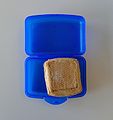Lunchbox
The term "bread box" was originally used to describe containers for transporting sandwiches. Regionally, the names for similar containers vary greatly. In northern Germany it is called a "Patülle". In North-East Germany they are called "Stullendose", in East Germany (GDR times) "Brotschi", in West Germany "Butterbrotdose", in South Germany "Vesperdose" or "Brotzeitdose", in Austria "Jausenbox", in Saxony "Bemmenbüchse" and parallel in various combinations of the word components. If the shape was originally kidney-shaped due to the breads stored, the shapes vary according to use. Whereas originally mainly sheet metal and wood were used for production, the use of plastics now predominates.
The terms bread box and lunch box are also used for lunch boxes, which are used in English-speaking areas for storing lunch. However, these are usually larger, often resembling a small suitcase, and thus offer space for fruit, sweets or drinks. Parallel to the bread box, the handle man was used for transporting hot meals.
In Japan there are comparable containers called Bentō-box. They can be made of wickerwork, ornate boxes made of wood or lacquerware (Urushi (jap. 漆)) and are also available cheaply in plastic with a transparent lid. They usually hold sushi in an attractively decorated manner. Sometimes disposable chopsticks (wari-bashi) are included. Originally they had the same function as the lunch box, but are also offered ready-made by sushi restaurants as a small snack for on the go or at home. Comparable to Bentō is Dosirak (도시락) in South Korea and Kwakpap (곽밥) in North Korea.
· 
Blue plastic lunch box
· 
a three-piece Indian lunch box (Dawwa)
·
Old aluminium lunch box
See also
- Haversack
- Bread bin
- Bread cupboard
- Bread bag
- Bread Bin
Search within the encyclopedia
